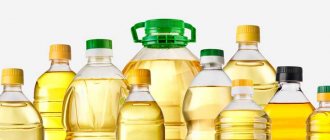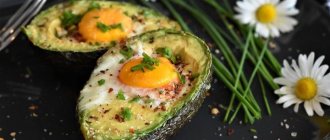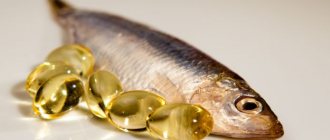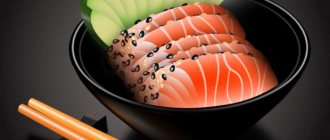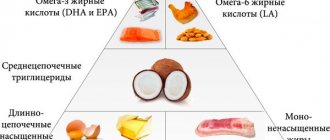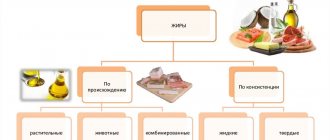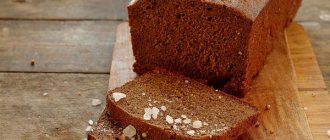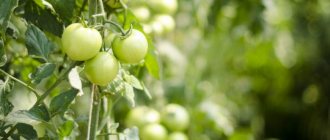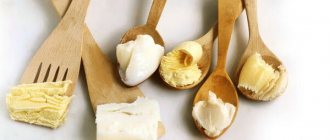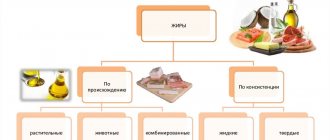Food fats are one of the main groups of organic substances that are included in the diet along with proteins and carbohydrates. Fats are a necessary and most high-calorie component of food. In the body, during the combustion (oxidation) of 1 g of fat, 9.3-9.8 kcal (34-41 kJ) of thermal energy is released, i.e. more than two times more than when burning 1 g of proteins or carbohydrates. Fats contribute to better and more complete absorption of other foods consumed along with them, giving them a more pleasant taste and aroma. However, fats are used by the body not only for energy, but also for plastic purposes. They are one of the main components of cells and intercellular membranes that regulate all aspects of the body’s life. With dietary fats, a person receives fat-soluble vitamins A, D and E, and fats contribute to their more complete use by the body.
An important component of dietary fats are physiologically active polyunsaturated fatty acids (linoleic and arachidonic), which are called essential acids because they are not synthesized in the body and are introduced only with food. These acids play an important role in fat metabolism processes. Liquid vegetable oils, especially sunflower, corn, soybean, etc., are relatively rich in polyunsaturated fatty acids.
A person’s need for fat depends on many factors and, first of all, on the energy expended, occupation, age, gender, as well as environmental climatic conditions. On average, this requirement is 1-1.5 g per day per 1 kg of weight (for example, for a person weighing 70 kg it is 70-105 g per day).
With an insufficient amount of fat, food becomes poorly nutritious (low-calorie), and with an excess of fat, food is difficult to digest and the associated overload of the body leads to obesity.
For better absorption of dietary fats, it is necessary that, with a pleasant taste and aroma, their melting point does not exceed 37-38°C. In this case, dietary fats are absorbed by 93-95%. Fats that melt at temperatures above 38°C are much less digestible, and food prepared with them leaves an unpleasant, greasy taste in the mouth. Fats that are emulsions with water (for example, butter, margarine) are well absorbed.
Under the influence of moisture, light, air and heat, edible fats deteriorate, “go rancid”, acquiring an unpleasant taste and smell, the color of fats usually changes and sometimes they become unsuitable for food. Rendered animal fats, vegetable oils and cooking fats are more shelf-stable than butter and margarine. With prolonged or repeated heating, deep chemical changes occur in fats (especially liquid vegetable oils containing polyunsaturated fatty acids), as a result of which their nutritional qualities are reduced.
The range of edible fats includes dozens of items. The main product groups of edible fats: milk fat, obtained from milk, mainly cow's milk - butter and ghee (Russian) butter; vegetable fats extracted from oil-containing seeds and fruits of plants; margarine and cooking fats made from vegetable oils or a mixture of vegetable oils and animal fats; rendered animal fats (they are rendered from the fatty tissue and bones of animals). Edible fats also include subcutaneous lard - lard.
Application of fats
Fats improve the taste of food and cause a long-lasting feeling of fullness because they are digested and absorbed more slowly than other nutrients. The amount of fat in the diet is determined by various circumstances, which include labor intensity, climatic conditions, and a person’s age. A person engaged in intense physical labor needs more high-calorie food, and therefore more fat. https://depils.com/reports that the climatic conditions of the north, which require a large expenditure of thermal energy, also cause an increase in the need for fats. The more energy the body uses, the more fat is needed to replenish it.
Principles of a balanced diet
Consumption of proteins, fats and carbohydrates in the right combination is the basis of a balanced diet. However, in addition to an adequately calculated amount of individual components, nutritionists recommend following a set of fairly simple principles:
- consume food in moderation, do not overeat;
- maintain the proportions of carbohydrates, proteins and fats as 3:2:1;
- diversifying your diet is both a prevention of overeating and a complete source of vitamins and microelements;
- consume food more often, but in smaller portions, for example, in five meals per day;
- focus on vegetables and fruits, as they contain fiber and dietary fiber;
- limit the amount of fatty, sweet and starchy foods, alcohol - although this is high in calories, it does not saturate the body with useful substances;
- Of the vegetable oils that are so necessary for the body, it is necessary to give preference to those that have not undergone heat treatment, that is, for example, season fresh salads with them;
- limit your intake of salt and refined sugar;
- The amount of plain still water consumed per day should reach 2 liters.
Fats contain:
In addition to their high calorie content, the biological value of fats is determined by the presence of fat-soluble vitamins (A, D, E) and polyunsaturated fatty acids. Fats (or lipids) are synthesized by absolutely all living organisms and consist of “small” elements - fatty acid residues.
Based on the saturation of fatty acids with hydrogen atoms, they are divided into two large groups:
- Saturated fats
- Unsaturated fats
The most nutritionally valuable are unsaturated fatty acids. Some of them are not synthesized in the human body and are therefore essential. Vegetable fats mainly consist of unsaturated fatty acids. They are absorbed faster by the body and bring much more benefits than animal fats.
Polyunsaturated fatty acids - linoleic and arachidonic - are essential, since their synthesis in the body is extremely limited. They play an important role in metabolism: their lack in nutrition negatively affects the functioning of the human body. Linoleic acid makes up up to 50% or more of all fatty acids contained in vegetable oils.
What are the benefits of fats for the body?
First of all, it is protection.
The surface of the human body is protected from injury and damage, as well as from hypothermia, by a layer of subcutaneous fat. The most important internal organs, such as the kidneys, are surrounded by a fairly thick layer of fat that protects them from shocks and bruises.
The statement from biochemists at the University of California shows the role of oleoylethanolamide, a fatty acid that affects human hunger. This molecule is part of many natural fats, and when it is deficient, hunger is felt, and conversely, a sufficient amount of it dulls the feeling of hunger, sometimes even at a clearly low level of calories.
Another important role of fats in the human body is its high degree of resistance to infections and radiation.
The bottom line is that human fat cells produce cytokines - substances involved in the functioning of the immune system.
Scientists and doctors studying why the body needs fats show that people who refuse to consume fats have lower levels of beneficial forms of cholesterol in the blood. And this leads to atherosclerosis, increased irritability and depression, as well as a decrease in mental abilities in childhood.
Long-term diets that sharply limit fats lead to hypovitaminosis.
Low libido, decreased sperm quality, infertility and impotence in men can be a consequence of a lack of healthy fats in the body.
After all, the male sex hormone testosterone, like many other hormonal substances, is formed from fats.
Therefore, it is worth understanding what fats do for the human body, which of them are beneficial and which are harmful.
Fat calories
The calorie content of animal and vegetable fats is approximately the same. Fats should account for about 30% of the calorie content of a person’s daily diet, i.e., daily dietary fat intake should be 90-100g. Taking into account the body's need for polyunsaturated fatty acids, 30% of the fat consumed should be vegetable oils and 70% animal fats.
Much attention is currently paid to the fat-like substances contained in fats - phospholipids, cholesterol and others, which are actively involved in various processes of the body. The requirement for phospholipids is about 5g. per day. They are found in significant quantities in fatty meats, egg yolks and other products. Cholesterol enters the body with products of animal origin and is also synthesized by it.
Fats should be used in quantities most favorable for replenishing energy expenditure.
It has been established that the daily fat requirement of an adult is satisfied by 75-110 g.
It should be noted, however, that the amount of fat in the diet is determined by various circumstances, which include labor intensity, climatic conditions, and a person’s age. A person engaged in intense physical labor needs more high-calorie food, and therefore more fat. https://depils.com/ The climatic conditions of the north, which require a large expenditure of thermal energy, also cause an increase in the need for fats. The more energy the body uses, the more fat is needed to replenish it.
Despite its importance in nutrition, fats are associated with many dietary restrictions due to the traditionally high fat content in many national diets. Currently, due to changes in living conditions and the quality of work, which increasingly requires mental expenditure and less physical, their large consumption only leads to health problems.
But we must not forget that excess fat, even in the diet of a healthy person, is harmful.
Fats do not dissolve either in water or digestive juices. In the body they are broken down and emulsified with the assistance of bile. Excessive fat does not have time to emulsify, disrupts digestive processes and causes the unpleasant sensation of heartburn.
A large amount of animal fat in food significantly impairs the absorption of proteins, calcium and magnesium, and increases the need for some vitamins involved in fat metabolism. It is from these disorders and limitations that various pathologies begin to form - for example, atherosclerosis, diabetes mellitus, gallstone disease. So it is better to limit the amount of fat in food, especially the amount of animal fat, and get energy from carbohydrates.
Effects of fats on the body
Nature provides for the use of fats in the body as the main source of energy.
Fat tissue is not completely consumed even during prolonged fasting or extreme overload. The amount of fat in men, subject to proper nutrition, is 15-20% of body weight, in women - up to 25%.
A higher percentage of fat leads to unpleasant side effects. Such people are less mobile, lethargic, their excess weight leads to overload of joints, ligaments and tendons. In more severe cases, problems arise related to heart function, hypertension, atherosclerosis, diabetes mellitus and others.
The importance of fats in the body is very high, since human survival in the natural environment depends on them.
Lack of food in the off-season, poor harvests and other natural disasters justified the presence of some excess fat.
In the modern civilized world, there is no point in accumulating excess energy, given the availability of necessary products throughout the year.
In addition, we should not forget about physical inactivity, that is, the fact that a modern person moves little and consumes more calories than he expends.
The human body has a certain number of fat cells, genetically determined. Excessive nutrition and an unhealthy lifestyle can lead to an increase in the volume of a fat cell by 900 times its original volume, and this leads to an increase in the weight of the entire body with all the ensuing consequences.
Nutritional value of fats
The nutritional value of different fats is not the same and largely depends on the digestibility of fat by the body. The digestibility of fat, in turn, depends on its melting temperature. Thus, fats with a low melting point, not exceeding 370 (i.e., human body temperature), have the ability to emulsify most completely and quickly in the body and, therefore, are most fully and easily absorbed.
Fats with a high melting point are absorbed much less well. While butter is absorbed by the body up to 98.5%, lamb fat is absorbed only by 80-90%, beef fat, depending on its melting point, by 80-94%.
Fats with a low melting point include butter, lard, goose lard, all types of margarines, as well as liquid fats.
Fats with a high melting point are absorbed much less well. While butter is absorbed by the body up to 98.5%, lamb fat is absorbed only by 80-90%, beef fat, depending on its melting point, by 80-94%.
Fats in sports nutrition: meaning, types, sources
Fats in sports nutrition: meaning, types, sources
Low-fat diets are gaining popularity in the sports community. Nutritionists never stop talking about the need for fat in a healthy diet for athletes. Where is the truth?
sports nutrition, cholesterol
Fats are macronutrients that are part of the protein-fats-carbohydrates triad. Traditionally, fats are relegated to the role of “unloved relatives” - you really want to get rid of them, but this is difficult to do. This picture emerges especially clearly in sports nutrition, where carbohydrates are a source of energy, proteins are building materials for muscles, and fats are a risk factor, the cause of excess weight gain, empty calories and cholesterol.
In fact, this type of macronutrients rightfully has a place in a complete sports nutrition, but it is necessary to understand exactly what fats athletes need and why.
Fat in cooking
It is difficult to overestimate the importance of fats in cooking. One of the main culinary processes - frying - is usually carried out with the help of fats, since due to poor thermal conductivity, fat makes it possible to heat the product to high temperatures without burning or igniting. By forming a thin layer between the bottom of the pan and the product being fried, fat promotes more uniform heating.
Due to its ability to dissolve some coloring and aromatic substances extracted from vegetables, fat is also used to improve the appearance and smell of food. It is well known that the taste and nutritional value of food can be improved by adding various fats to it. When selecting fat for preparing a particular dish, the cook must take into account not only its digestibility by the body, which is especially important when preparing dietary and baby foods, but also how this fat reacts to strong heating.
Not all fats can be heated to high temperatures without decomposition, which is detected by the appearance of smoke. The temperature of smoke formation is different. Butter, for example, can only be heated to 2080. As the temperature rises, it decomposes and gives the fried product an unpleasant bitter taste.
Pork lard without decomposition can be heated to 2210, and kitchen margarine to 2300. Kitchen margarines, in addition, contain a small amount of moisture, which makes them very convenient for frying various foods.
Ghee also cannot withstand heating to high temperatures. You can use it for frying only when you do not need to heat the product very much and when the frying process proceeds quickly. The choice of fat also depends on its taste compatibility with the culinary product.
All chefs know very well that the taste of a food is determined not only by the main product, but also by the fat used for its preparation. Fat that does not suit the taste of a given dish can worsen it. You cannot, for example, cook sweet pancakes with jam using beef or pork lard, and if there were no other fats suitable for these pancakes, then it was impossible to cook them and include them in the menu.
Incorrect selection of fat for preparing a given dish is a violation of one of the basic laws of cooking, and only an inexperienced, inept cook uses fats that do not match their taste with the product.
Butter
The delicate, subtle taste of many dishes corresponds to the pleasant smell and soft taste of butter.
Butter is used primarily for sandwiches, as well as for topping a number of prepared foods, especially those prepared from dietary and deli products, as well as for seasoning sauces.
You should not use butter for frying, especially because this oil contains up to 16% moisture and therefore splashes a lot. In many cases, butter can be replaced by all types of table margarine.
Animal fats
Animal fats - beef and lard - are used for hot meat dishes and frying some types of flour products. Lamb lard is successfully used to prepare many dishes of Caucasian and Central Asian cuisine.
Liquid fats vegetable oils
Liquid fats - vegetable oils - are used in all cases where the recipe requires the use of non-solidifying fat.
The use of a particular fat for different foods is often determined by its melting point. Thus, refractory fats can also be used in dishes that are served only hot. For those foods that are served both hot and cold, refractory fats are not suitable, since when they solidify they give an unpleasant aftertaste, as they say, “get cold on the lips.” For these dishes, it is advisable to use vegetable and cow oil, margarine, and lard. Despite the fact that margarine and lard also become dense when they harden, they quickly melt in the mouth and do not give the food a “greasy” taste.
Is it possible to eat foods high in fat?
We are accustomed to being wary of fats and carbohydrates. As soon as the need arises to lose weight or get in shape, we certainly give up fats or carbohydrates (or two components at once). Why is this bad and completely unreasonable?

According to the research “The effects of a low-carbohydrate diet on appetite: A randomized controlled trial”, for weight loss it will be quite enough to reduce the level of carbohydrate intake, but not give up on them!. Thanks to periodic changes in KBJU, due to carbohydrates, it will be possible to lose/gain weight and reduce the risk of developing heart and vascular diseases. A complete rejection of fat will cause hormonal and energy disruptions, after which you can easily end up in a hospital ward.
Is there a connection between fats and weight gain?
The fear of extra pounds is based on the following fact: 1 gram of fat is 2 times more caloric than 1 gram of carbohydrates or proteins. But many people forget that the human body is a carefully thought-out machine in which complex biochemical processes occur every second. Simple mathematics does not always apply to the process of forming and burning fat. Why?
Calories that come from different foods (protein, carbohydrates, fat) have different effects on the body. This uneven impact extends to metabolic processes, hormonal levels, the immune system, brain function, internal microflora and even genes. Nutritionists have conducted many studies and proven: natural healthy weight loss is possible only with normal fat consumption and a reduced concentration of carbohydrates. The opposite statement is a myth on which large companies and inept nutritionists make money.
What kind of fats can you eat?
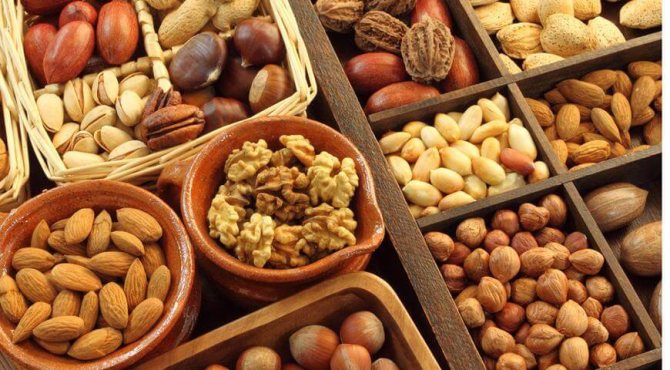
Vegetable fat is considered the healthiest and safest. It is generated for humans by nature itself and enters the body almost in its original form. The first thing you need to pay attention to is nuts and oils. PROMED came to the defense of unsaturated vegetable fats with the publication “Primary Prevention of Cardiovascular Disease with a Mediterranean Diet.” Scientists say that oils from walnuts, almonds, olives and sunflowers can:
- regulate blood cholesterol levels;
- prevent diseases of the heart and blood vessels, improve their functionality;
- enrich the body with vital vitamins and nutrients;
- promote natural weight loss;
- have a beneficial effect on female and male hormonal levels;
- improve external data - the condition of hair, skin, nails.
Also, nutritionists advocate adding various seeds (pumpkin, flax, hemp and others) to the diet. They protect cells from oxidative processes, thereby maintaining their integrity and functionality. Also, healthy seeds regulate blood glucose levels and protect the body from diabetes.
Remember: there is a huge difference between a handful of pecans and deep-fried ice cream.
High-quality oils are found only in products of plant origin. It is desirable that the product undergoes minimal processing or enters the body in its pure form. Unprocessed plant products retain their integrity and have a beneficial effect on the body. Plant foods containing healthy fat
| Nuts | Oils | Seeds |
| Peanut | Ghee | Chia |
| Hazelnut | Olive | Linen |
| Pistachios | Cocoa | Pumpkin |
| Almond | Hemp | Cedar |
| Walnut | Coconut | Sunflower |
Vegetable fats
Vegetable fats are extracted from the seeds of oilseed plants by pressing or extraction.
The essence of the pressing process is to squeeze oil out of crushed seeds, from which most of the hard shell (peel) has been previously removed. Depending on the method of conducting the technological process, cold-pressed and hot-pressed oil are distinguished. During hot pressing, crushed seeds are preheated in roasters. Extraction consists of a number of sequential operations: cleaning, drying, removing the shell and grinding the seeds, extracting oil from them using special solvents and then removing the solvent from the oil.
Vegetable oil is purified either by filtration or by exposure to alkalis. In the first case, the product is called unrefined, in the second, refined. The oil obtained by extraction is edible only in refined form.
Refined vegetable oil is most suitable for frying, since particles of mucous and protein substances remaining in unrefined oil when fat is heated to a high temperature quickly decompose and can give the fried product a bitter taste and a specific unpleasant (“smoky”) odor.
Some vegetable oils, in addition to refining with alkali, are subjected to bleaching and deodorization. Deodorization is achieved by reducing or completely eliminating the specific odor of the oil. Of the vegetable oils, the range of which is very wide and includes fats with different chemical and physical properties, the most commonly used in cooking are sunflower, cottonseed, olive, soybean, and peanut; flaxseed, hemp, and corn oils are less commonly used. In confectionery production, sesame and nut oils are used, and in baking, mustard oil is used.
Sunflower oil
Sunflower oil is obtained by pressing or extracting sunflower seeds. The oil, produced by pressing and especially hot, has an intense golden yellow color and a pronounced aroma of roasted seeds. Sunflower oil is sold refined and unrefined. Refined and deodorized oil is transparent and almost devoid of a specific odor.
According to its commercial qualities, unrefined sunflower oil is divided into three grades (highest, 1st and 2nd).
Dressings for salads, vinaigrettes, and herring are prepared using sunflower oil. It is used in cold appetizers, especially vegetable ones (squash, eggplant, mushroom caviar, stuffed peppers, eggplants, tomatoes). The same oil is used for frying fish, vegetables and some dough products. Refined and deodorized sunflower oil is most suitable for salad dressings, as well as for making mayonnaise.
Olive oil
Olive oil (Provençal oil) is extracted from the fleshy part of the olive tree and from the kernel of its hard pit. The best food grade olive oil is obtained by cold pressing. Olive oil has a delicate, soft taste and pleasant aroma. It is used for preparing dressings and frying some meat, fish and vegetable products.
Cottonseed oil
Cottonseed oil is obtained from the seeds of the cotton plant. For food purposes, this oil must be refined with alkali, since unrefined oil contains a toxic substance - gossiopol.
Refined and deodorized cottonseed oil has a good taste. The color of this oil is straw yellow. In cooking, cottonseed oil is used in the same cases and for the same purposes as sunflower oil.
Soybean oil
Soybean seeds contain 20 to 25% oil, which is extracted from them by extraction or pressing. Due to its good taste, this oil is widely used. Therefore, every year more and more areas are sown with soybeans. The main growing areas of soybeans are the Far East, Ukraine, and the North Caucasus. Soybean oil is used only in refined form and for the same purposes as sunflower or cottonseed oil.
Flaxseed and hemp oil
After refining, linseed oil can be used for food purposes, but in cooking these fats are rarely used, since they have very limited storage stability, quickly thicken and are unsuitable for frying, as they give the fried product a specific “drying oil” flavor.
Mustard oil
Oil is obtained from the seeds of white or blue mustard, which, after careful purification, has a pleasant, mild taste. The color of refined mustard oil is intensely yellow. The specific smell of this oil, which is particularly well suited to some dough products (mustard bread is prepared with mustard oil), does not make it possible to widely use it for other culinary products.
Corn oil
To obtain oil, the germ of corn kernels is pressed or extracted. Refined corn oil is golden yellow in color; it is used in the manufacture of confectionery products.
Peanut butter
The walnut kernel contains up to 58% fat. Cold pressed nut oil has a light yellow color, pleasant taste and smell; it is used in confectionery production.
Peanut butter
This oil is produced from the peanut kernel (groundnut). Refined oil obtained by cold pressing has a good taste and pleasant aroma. It is used as a salad dressing and for frying. Peanut oil is also used in confectionery production.
Lesson #18. Lecture. Edible fats and oils.
Section 1.
Assortment and characteristics of the main groups of food products.
Subject:
Edible fats and oils.
Assignment:
Answer questions on the topic:
Edible fats and oils.
1.
Goal of the work:
— educational: acquire skills in determining the quality of edible fats and oils.
— developing: develop independent work skills; develop the ability to analyze a work situation, organize, evaluate and adjust one’s own activities, and take responsibility for the results of one’s work; search for information;
- educational: to instill responsibility, hard work, accuracy.
Lesson type:
consolidation of educational material
Method:
lecture session
Lesson equipment:
Handout.
Procedure for completing the task:
1.
Study theoretical material
.
2. Answer the questions asked.
3.
Write down the answers to the questions posed in a brief form in a notebook for this academic discipline.
Task deadlines:
Submit the completed work to the teacher by ………..
via email, Viber, WhatsApp, VKontakte group.
Organization of feedback:
consultations, answers to questions via email, Viber, WhatsApp, VKontakte group.
Work control form:
completed assignments on the topic.
List of tools used when performing work:
1. SanPiN 2.3.2.1078-01. Hygienic requirements for the safety and nutritional value of food products. Sanitary and epidemiological rules and regulations.
2.GOST R 51074-2003 Food products. Information for the consumer. General requirements, etc.
Sources for studying the material/completing the assignment:
Main sources:
1.T.G.Kachurina “Fundamentals of nutritional physiology, microbiology and sanitation. 2021
Additional sources:
1.Z.P.Matyukhina. “Fundamentals of nutritional physiology, microbiology, hygiene and sanitation” 2009-20.
Theoretical part:
Fats are a high-calorie food product. When 1 g of fat is oxidized in the body, 37.7 kJ, or 9.3 kcal of energy, is released. Fats have not only calorific value, but also great physiological significance.
Together with them, the human body receives the necessary fatty acids, vitamins, phosphatides and other substances. Particularly biologically valuable are vegetable oils, which contain unsaturated fatty acids - linoleic and arachidonic, which to some extent reduce the formation of substances that cause atherosclerosis. With insufficient fat consumption, the body's resistance to cold and infectious diseases decreases. Fats play a big role in the process of culinary processing of foods. Many fats can withstand very high heating temperatures (200-300°C) without decomposing or flaming, and they dissolve aromatic and coloring substances well. Thanks to this, it is possible to obtain dishes with good taste and aroma properties and a beautiful appearance.
By origin of fats
divided into plant, animal and combined.
The nutritional value of vegetable oils is due to their high fat content, their high degree of absorption, as well as the content of biologically valuable substances for the human body - unsaturated fatty acids, phosphatides, fat-soluble vitamins, etc.
The raw materials for obtaining vegetable oils are seeds of oilseeds, as well as germs of seeds (corn) and fruits (olives). In Russia, the main raw material for the production of vegetable oils is sunflower seeds, containing from 39 to 60% fat (in terms of dry matter). Seeds of flax, hemp, cotton, peanuts, cedar and other oilseeds are also used. For food purposes, mainly sunflower, cottonseed, soybean, corn, peanut, mustard, olive, and sesame oils are used.
Sunflower oil
produced by pressing or extracting sunflower seeds. Depending on the organoleptic and physicochemical characteristics, it is divided into the following commercial grades and brands:
- unrefined oil - premium, grade I and grade II;
— hydrated oil — premium, I and II grades;
- refined, non-deodorized oil - not divided into grades;
— refined deodorized oil — grades D and P.
Oil grade D is intended for the production of baby and dietary food products: grade P for supply to retail and public catering chains.
Cottonseed oil
obtained by pressing or extracting pre-treated cotton seeds.
For food purposes, refined, non-deodorized (highest, 1st and 2nd grade) and deodorized oil (highest and 1st grade) is used. At a temperature of 10-12°C it begins to become cloudy, and at 0°C it completely hardens and turns into an almost solid mass. To obtain clear oil, it is cooled at a temperature of 7-8°C and filtered. Transparent oil is called cotton salad deodorized.
It is transparent, light yellow, tasteless and odorless.
Corn oil
produced by pressing or extracting corn germs. Depending on the processing method and purpose, it is divided into types and brands: refined deodorized grade D (for baby and dietary food products); refined deodorized grade P - for supply to retail chains and catering establishments; refined, non-deodorized and unrefined for industrial processing.
Soybean oil
obtained by pressing or extracting pre-treated soybean seeds. Soybean oil is produced in hydrated grades I and II; refined; refined bleached, refined deodorized. For food purposes, refined, deodorized, hydrated grade I oil (obtained by pressing) is used.
Olive oil
extracted from the fleshy part of the olive tree fruit, containing up to 55% fat. The olive tree grows in Crimea and on the Black Sea coast of the Caucasus. The best varieties of edible olive oil are obtained without using high processing temperatures of oilseed raw materials. It is one of the best vegetable oils.
Peanut butter
produced by pressing and extracting pre-processed peanut beans. The oil has a light yellow color with a greenish tint, without taste or smell. Depending on the degree of processing and quality, the oil is divided into types: refined deodorized (for food purposes) and non-deodorized; unrefined (highest, first grade and technical).
Mustard oil
obtained from peeled and dehulled benign mustard seeds by pressing. They produce one type of oil - unrefined; According to its quality, it is divided into the highest, I (for food purposes) and II grade (for technical purposes).
Sesame or sesame oil
produced by pressing pre-peeled sesame seeds. For food purposes, refined oil is used, as well as unrefined oil of grades 1 and 2. Imported vegetable oils of various names depending on the type of oil raw material, as well as mixtures of vegetable oils, are supplied only refined and often, along with the type of oil, the brand is indicated on the label: “Oleina”, “Ideal”, etc.
Requirements for the quality of vegetable oils.
When checking the quality of vegetable oils, attention is paid to the following indicators: transparency, color, taste and smell. Refined deodorized oils must be transparent, without sediment, odorless, and have an impersonal taste. Olive oil has a weak natural smell and taste, mustard oil has its own characteristic smell and taste, without foreign smell, taste or bitterness; sesame - pleasant delicate taste, without bitterness. A little sediment is allowed in unrefined oil. Of the physicochemical indicators, the standard standardizes: color number, acid number, moisture and volatile substances content, iodine number, etc.
Not allowed for sale
vegetable oils with defects: rancid, greasy, musty, moldy taste and smell; intense turbidity, and in oils that should not have sediment, precipitation.
Packed
vegetable oils in boxes. They are produced packaged and bulk. Refined deodorized oils for retail are produced only in packaged form, in glass bottles with a capacity of 500, 400, 250 g, as well as in bottles made of colored polymer materials from 400 g or more. Oil bottles must be hermetically sealed. Bottles of oil are placed in wooden nesting boxes or in containers made of polymer materials. It is allowed to pack bottles made of polymer materials in cardboard boxes, and for local transportation - in open metal boxes. The boxes are also marked accordingly.
Store
bottled vegetable oil in dark rooms at a temperature not exceeding 18°C and a relative air humidity of 85% not more than 4
The raw material for the production of rendered animal fats is adipose or bone tissue separated during the primary processing of cattle, sheep, pigs, as well as adipose tissue of poultry. Depending on the location of deposition, raw lard can be subcutaneous, internal, or intermuscular. Internal fat has a higher melting point than subcutaneous fat. The fat located on the internal organs is of varying quality. The best fat is considered to be the fat of the omentum, as well as the fat located near the kidneys and heart. Fat removed from the stomach and intestines has a specific unpleasant odor. Raw lard intended for melting is sorted, meat cuts are removed, and washed in cold water to remove residual blood and other contaminants.
There are two methods of rendering fat:
dry and wet.
With the dry method
fatty raw materials are heated in boilers (with steam heating) without adding water. When heated, fat increases in volume and is released from the cells, accumulating on the surface. The remains of the destroyed tissue, called greaves, settle to the bottom. The floating fat is separated and filtered. The fat obtained by this method is shelf stable, but has a dark color and a specific smell of fried greaves.
With the wet method
fatty raw materials are in direct contact with water. This prevents burning of raw materials. However, the remaining connective tissue of the greaves is boiled in water, and the resulting broth is difficult to separate from the fat, which makes the fat less stable in storage.
Currently, fat is obtained using the wet method in continuous installations.
This reduces the process of fat burning (up to 10-12 minutes) and the time of exposure to factors that adversely affect the quality of fat. Fats obtained by the continuous method retain vitamins, phosphatides and other biologically valuable substances.
Assortment of rendered animal fats.
The most common rendered animal fats are beef, lamb, pork, bone, prefabricated, and horse. Oleoproducts are obtained in smaller quantities: beef oleo-oil, lamb ship-oil, as well as goose, chicken and duck fats. Depending on organoleptic characteristics, acid number and moisture content, rendered animal fats are divided into premium and 1st grade, with the exception of poultry fat and combined fat. Poultry fat is divided into grades 1 and 2, but prefabricated fat is not divided into grades.
Beef fat
has a pale yellow or yellow color, pleasant taste and smell, dense or hard consistency at 15-20°C. In the molten state it is transparent. In 1st grade fat, a light crispy taste is allowed. Beef fat has a high melting point (42-52°C), which causes its low digestibility (80-94%).
Lamb fat
has a color from white to pale yellow in the highest grade and to yellow in the 1st grade, taste and smell characteristic of this type of fat; in the 1st grade, a slightly toasty taste is allowed. The consistency at a temperature of 15-20°C is dense or hard, for fat tail fat it is ointment-like. When melted, the fat is transparent. Melting point - 44-45″C. The digestibility of lamb fat is 80-90%.
Pork fat
has a white color. In 1st grade fat, a yellowish or grayish tint, as well as a crispy taste, is allowed. The consistency at a temperature of 15-20°C is ointment-like or dense. The melting point of pork fat is 36-42°C.
Bone fat
has a color from white to yellow. In the 1st grade, a grayish tint, taste and smell characteristic of this product are allowed. In the 1st grade, a pleasant crispy taste and a taste of fresh broth are allowed. The consistency at 15-20°C is liquid, ointment-like or dense.
Prefabricated fat
collected from the surface of the broth when cooking sausages, smoked meats, offal, etc. The color of the fat is from white to dark yellow. Grayish and greenish shades are allowed, as well as the smell and taste of greaves, broth, spices, and smoked meats. When melted, the fat may be cloudy. The consistency is liquid, ointment-like or dense.
Rendered animal fats (except for combined fats) contain moisture from 0.2 to 0.3%, depending on the type and variety.
Packaging and storage of rendered animal fats.
Rendered animal fats are packaged in wooden or plywood stamped barrels, as well as in plank, plywood or cardboard boxes weighing no more than 30 kg. The inside of the container is lined with parchment or film. For small packaging, cardboard, paper, glass, metal and polymer containers are used.
Store
rendered animal fats at temperatures from -5 to -8°C without a noticeable change in quality for up to 6 months. In stores, it is recommended to store these fats at a temperature of 0-4°C and a relative humidity of about 80% for no more than a month.
Margarine
is a highly dispersed fat-water system, which includes high-quality edible fats, milk, salt, sugar, emulsifiers and other components. It is used directly as food, for making sandwiches, as well as culinary, confectionery and bakery products. In terms of calorie content, margarine is not inferior to butter, and in some respects it has advantages. Thus, margarine contains significantly more unsaturated fatty acids, which are introduced into it by adding vegetable oil; The melting point of margarine is 17-44°C, which facilitates its absorption; The lack of vitamins is compensated for by artificial fortification of the product. Margarine contains from 39 to 82% fat and moisture from 17 to 44%. Its digestibility reaches 97.5%. The calorie content of 100 g is 640 kcal.
The main raw material for the production of margarine is lard.
It is obtained through the process of hydrogenation of liquid vegetable and animal fats, when the unsaturated fatty acids that make up liquid fats are saturated with hydrogen and the fat turns into a solid state. Food fat can be either vegetable or whale, depending on the source of fatty raw materials. In addition, natural refined oils, coconut oil, and animal fats are used as a fat base for the production of margarine. Sugar, salt, cocoa powder, dyes, emulsifiers, flavorings, etc. are used as additional raw materials. Milk is used to enhance the taste.
Depending on the purpose
margarines are divided into brands:
— hard:
MT - used in baking, culinary confectionery production, and home cooking; MTS - used in the production of puff pastry; MTK - intended for the preparation of creams, fillings in flour confectionery products, soufflés, Bird's Milk sweets and other sugary and flour confectionery products;
— soft:
MM - intended for direct consumption, use in home cooking, in public catering and in the food industry;
— liquid:
MFA - used for frying and preparing baked goods in home cooking and public catering; MZhP - for the industrial production of bakery and baked confectionery products, as well as frying products in public catering networks.
By fat content
margarines can be divided into high-fat (80-95%), low-fat (65-72%), low-fat (40-60%).
In the overall production of margarine, the leading place in recent years belongs to low-calorie types, since the consumption of these products as sandwich products allows one to reduce daily fat intake.
Currently, the range of margarine products
expanded significantly. The retail chain supplies mainly hard and soft margarines with reduced fat content and low calories.
For hard margarines
refers to “Chudesnitsa” (60% fat); “Homemade” (60% fat); "Hostess" (65% fat); “Pyshka” (75% fat); “Creamy new” (65% fat), etc.
Assortment of soft margarines
represented by the following names: “Rossiyanka” (75% fat); “Stolichny” (60% fat); “Morning” (40 and 50% fat); “Creamy” (60% fat); “Homemade” (50% fat); “Russian” (50% fat), etc.
Requirements for the quality of margarines.
The taste and smell of margarines of all brands must be pure with the taste and smell of the introduced food flavoring and aromatic additives, depending on the specific name, without foreign tastes and odors.
The consistency for hard margarines at a temperature of 20 ± 2″C is plastic, dense, homogeneous; when introducing food flavoring additives, smearing is allowed; for soft ones - at a temperature of 10 + 2 ° C, plastic, soft, fusible, homogeneous; for liquid ones - the consistency is homogeneous, liquid. The cut surface is shiny or slightly shiny, dry in appearance for all brands except liquid ones. The color should be from light yellow to yellow, uniform throughout the mass. Fat content: hard - 39-84%, soft - 39-82%, liquid - 60-95%. Moisture content: in hard and soft materials no more than 61%, in liquids no more than 40%. Melting point of fat: for solids: MT and MTK (27-38°C), MTS (36-44°C; for soft (25-36°C); liquid (17-38°C).
Margarine defects.
The characteristic defects of margarine are the following:
Greasy and rancid tastes
appear due to the poor quality of the fatty raw materials used and improper storage of margarine.
Clearly expressed taste of vegetable oil
formed when using insufficiently refined oil.
Unclean taste
is the result of poor deodorization of fats and improper storage of margarine.
Protrusion of water drops on margarine
(tear) - a consequence of poor emulsification.
Crumbly soft or hard consistency
is formed when the technological regime of margarine production is violated.
Packaging margarine
in boxes, drums and barrels. It is produced in packaged and bulk form. Branded margarine for retail trade is produced only in packaged form. Margarine is packaged with a net weight of 200 to 500 g in the form of bars, wrapped in parchment or laminated foil, as well as in containers of various shapes made of polymer materials.
The artistically designed label must indicate the trademark and name of the manufacturer, the name of the margarine, as well as the net weight, a list of main components, calorie content per 100 g, production date, shelf life and standard number.
Packaged products are placed in wooden or cardboard boxes weighing from 10 to 25 kg.
Bulk margarine is packaged in wooden, plywood or cardboard boxes from 10 to 25 kg, as well as in drums or barrels weighing no more than 50 kg. Before packaging, the container must be lined with parchment or polymer films.
Store
margarine at a relative humidity of 75-80%. The shelf life of margarine from the date of its production depends on the storage temperature. At temperatures from -10 to 0°C, bulk margarine is stored for 75 days, above 0 to 4°C - 60 days, from 4 to 10°C - 45 days. Margarine packaged in parchment is stored at the same temperatures for 45, 35 and 20 days, respectively, and packaged in foil for 60, 45 and 30 days.
In recent years, a fairly wide range of imported margarine, mostly low-calorie, has been presented on the domestic market. Among the low-calorie types of margarine, the most widely represented are dairy-free ones - halvarins.
These are highly plastic, finely divided products with a melting point of the fat base of about 30°C.
Soft (fluid) Dutch halvarins: Torper, Summer, Rilanto, Linco; Finnish margarines: Voimix and Rama; Maslo margarine comes from Germany; from Denmark - Nille and Mira, etc.
Almost all imported margarines are high quality products with high biological value (contain vitamins and other components), have good organoleptic characteristics: the taste and aroma of butter, highly plastic consistency, good spreadability, and the color of summer butter. But their sale on the domestic market as sandwich butter is illegal, since margarine is not a dairy product in terms of its composition and raw materials used.
ulinary fats
are an anhydrous mixture of various animal and vegetable fats. Hydrogenated vegetable oils, rendered animal fats and whale oil are used as raw materials for their production.
The fat mixture is prepared according to the approved recipe. Various components are added to cooking fats depending on the melting point of the mixture, which should be in the range of 30-40°C. The prepared fat mixture is heated, stirred to ensure uniform distribution of the introduced components and quickly cooled.
Fats depending on purpose
are divided into types: culinary, confectionery (for cookies, chocolate products, sweets, waffle fillings), bakery (have a liquid consistency at 16°C).
According to the type of raw materials used and purpose
Cooking fats are divided into the following types:
Vegetable lard
produced from a mixture of vegetable lard (75-80%) and natural vegetable oil (15-25%).
Frying fat
made from vegetable lard; it is possible to add lard from whale oil.
Belarusian fat
obtained from a mixture of vegetable and whale oil (60%), vegetable oil (20%) and beef fat (20%).
Ukrainian fat
produced from a mixture of edible lard (vegetable and whale), vegetable oil and pork fat (30-40%).
Eastern fat
obtained from a mixture of edible lard (vegetable and whale), vegetable oil and lamb fat (15%).
Margaguselin
made from lard (40-70%), pork fat (20%) and vegetable oil (10-30%). The flavoring is an oil extract from fried onions.
Cooking fats are substitutes for rendered animal fats.
The color of cooking fats should be from white to light yellow. the taste and smell must correspond to the name of the fat. The consistency is solid and homogeneous. When melted, cooking fats should be transparent. Cooking fats contain at least 99.7% fat and no more than 0.3% moisture. Their melting point is from 18 to 36°C, depending on the type.
Packed
culinary fats in plywood or cardboard boxes weighing up to 30 kg, as well as in wooden barrels and plywood drums. They are produced in small packaging in bags made of greaseproof polymer films or in the form of bars wrapped in parchment, 200-500 g each, as well as in cans of 0.5 and 1 kg.
Store
cooking fats at temperatures from -4 to -6°C for up to 12 months, at 1-4°C - 6 months, at 5-10°C - 3 months, and at 11-18°C - up to 1 month. Relative humidity should be 80%.
Animal fats
The type of animal, its age, fatness, feed, place of deposition and depth of fat in the carcass are all factors that influence the chemical composition and properties of animal fats, increasing or decreasing the nutritional value of the product and determining its most correct and appropriate use for culinary purposes. .
Animal fats widely used in cooking include beef, lamb and lard. It is also impossible to ignore such a high-quality product as poultry fat (goose, duck, chicken).
Lamb fat
Lamb fat is one of the hardest and most refractory animal fats. Depending on the age of the animal and the location of fat deposition, the melting point of lamb fat ranges from 44 to 51°.
Beef fat
Beef fat is more fusible and soft (melts at a temperature of 42-49°) and, finally,
Pork fat
Pork fat, the softest in consistency (melts at 33-40°).
For rendering fat, raw lard is used, i.e., fatty tissue removed from the outer or inner parts of the carcasses of cattle, pigs and sheep. Raw beef lard, intended for rendering fat of the highest grades, is removed from carcasses of fatty, above-average and medium fatness, and for these grades only lard from fresh, not frozen carcasses is used. Depending on the age of the animal and the location of deposition, raw beef lard has a white or light yellow color.
Lard removed from the digestive organs is grayish in color and, unlike external and internal fat, sometimes has a specific odor. To prepare the highest grades of lard, fatty tissue is used, removed from the internal and partly external parts of pork carcasses of greasy, semi-greasy and meat fatness. Extra-grade lard is prepared from fresh, selected, mainly perinephric fat.
Where and in what quantities are proteins, fats and carbohydrates found?
The human body obtains proteins, fats and carbohydrates It is a varied but balanced diet that allows you to supply the body with these components and the necessary vitamins and minerals.
Each food product is a combination of proteins, fats and carbohydrates with a certain predominance of one. For example, 100 grams of cottage cheese will bring about 15 grams of protein to the body, and 100 grams of pasta is a source of 60 grams of carbohydrates, which is why cottage cheese is considered more of a protein product, and pasta is considered a carbohydrate product.
So, below is a table of the predominant content of proteins, fats and carbohydrates in certain foods:
| Squirrels | |
| 100 grams of product | Quantity of substance |
| Cheeses, low-fat cottage cheese, animal and poultry meats, most fish, soybeans, peas, beans, lentils, nuts | 25-15 grams |
| Fat cottage cheese, pork, boiled sausages, sausages, eggs, semolina, buckwheat, oatmeal, millet, wheat flour, pasta | 10-15 grams |
| Rye and wheat bread, pearl barley, rice, green peas, milk, kefir, sour cream, potatoes | 5-10 grams |
| Other vegetables, fruits, berries and mushrooms | < 2 grams |
| Fats | |
| 100 grams of product | Quantity of substance |
| Oil (vegetable, ghee, butter), margarines, cooking fats, pork lard | > 80 grams |
| Sour cream (>20% fat), cheese, pork, duck, goose, semi-smoked and boiled sausages, cakes, halva and chocolate | 20-40 grams |
| Cottage cheese (>9% fat), ice cream, cream, lamb, beef and chicken, eggs, beef sausages, sausage, salmon, sturgeon, saury, herring, caviar | 10-20 grams |
| Low-fat cottage cheese and kefir, pike perch, cod, pike, hake, cereals, bread | < 2 grams |
| Carbohydrates | |
| 100 grams of product | Quantity of substances |
| Sugar, candy, honey, marmalade, butter cookies, cereals, pasta, jam, dates, raisins | 65 grams |
| Bread, beans, peas, oatmeal, chocolate, halva, cakes, prunes, apricots | 40-60 grams |
| Sweet curd cheese, green peas, ice cream, potatoes, beets, grapes, cherries, sweet cherries, figs, bananas | 11-20 grams |
| Carrots, watermelon, melon, apricots, peaches, pears, apples, plums, oranges, tangerines, currants, strawberries, gooseberries, blueberries, lemon | 5-10 grams |
Fat processing
The technological process of processing animal fats consists of the following operations: cooling, washing with cold water, grinding adipose tissue and melting fat.
Salot heating can be carried out using dry and wet methods. With the dry rendering method, raw lard is loaded into a lard boiler that has double walls. After burning the raw material for rendering fat, it is produced with steam or hot water.
With the wet rendering method, raw lard is poured into a boiler with water and in this form is heated with steam. With this method of rendering, the adipose tissue releases the greatest amount of fat; however, along with fat, nitrogenous substances also enter the broth, which reduce the stability of fat during storage. The best results are obtained by dry lard heating in double-walled boilers heated by water or steam. This method of rendering lard protects the greaves - the fabric remaining after rendering fat - from burning and ensures very good quality of the finished product.
Beef fat
To obtain high-quality beef lard, extra fat extraction is carried out in two stages. The fat obtained after the first rendering is called the first juice. By separating the part, extra grade beef fat is obtained. Extra beef fat is used in cooking for frying meat products. This high-quality fat has a low melting point (not higher than 320). The fat has a pleasant taste and smell. https://depils.com Due to its good taste, it is also used in other hot dishes and is used for frying foods in large amounts of fat (deep frying).
Premium beef fat is prepared from selected, fresh, raw lard. The color of the fat is light yellow or yellow. The consistency at room temperature is solid; when melted, this fat is transparent. The taste of premium beef fat should be pure, without any foreign taste or smell.
Beef fat of the 1st grade is rendered from internal raw lard. In color and consistency, it differs little from premium fat, but this product may have a slight aftertaste of crispy greaves.
Beef fat of the 2nd grade is prepared from benign raw lard. For produce in this class the standard allows for a slightly grayish or pale green hue and a roasted greave odour. When melted, grade 2 beef fat may not be clear enough.
Lamb fat
This fat is available in three grades. The highest grade lamb fat is rendered from selected fresh raw fat from the inner and tail parts of the carcass. The color of the finished product is white or pale yellow; The consistency is solid; when melted, the fat is transparent. The taste and smell of this fat are specific to the inherent taste of lamb.
Lamb fat of the 1st and 4th grades is prepared from benign raw lard. These products are characterized by a slightly grayish or greenish tint and the taste of crispy greaves. 2nd grade fat may be slightly cloudy when melted.
Pork fat
This fat is available in four grades. Extra pork fat is prepared from selected perinephric fat from pork carcasses. In terms of its culinary qualities, taste, smell and nutritional value, this fat is deservedly considered the best of all animal fats (except butter). All varieties of pork fat, especially extra, are widely used in cooking for a wide variety of dishes and dough products.
Extra grade pork fat has a white color, a soft and delicate taste, with a slightly pleasant sweetish taste and a barely noticeable delicate odor. At room temperature, pork fat has an extra spreadable consistency. When melted, pork fat is extra transparent.
Pork fat of the highest quality is rendered from fresh, selected raw lard, removed from the inside of the carcass. In terms of smell, color, taste and consistency, it differs little from extra fat.
Pork fat of the 1st and 2nd grades is rendered from benign raw lard. 1st grade fat is made from internal lard, and for 2nd grade all types of fresh raw lard are used. The color of the fat is white with a slight yellowish tint; consistency is thick or pasty. In the melted state, 1st grade fat is transparent, 2nd grade fat may be cloudy. Both varieties have the smell of crispy greaves.
The ideal balance of proteins, fats and carbohydrates in the diet
The combination of these power components may vary in some details. It is believed that the average person of normal build (who does not strive to lose weight or gain weight) needs to compose his diet in such a way that half of the components entering the body per day are represented by carbohydrates, a third by proteins, and a fifth by fats. Thus, a normal balanced diet is represented by the formula BZHU 30% -20% -50%. However, a wide variety of variations are possible, for example:
- low carbohydrate - 40% protein, 25% fat, 35% carbohydrates,
- drying - 80% proteins, 10% fats, 10% carbohydrates.
The simplest way to understand the formula of a balanced diet and its subsequent implementation is to conditionally divide the dish into 6 sectors, three of which must be allocated for carbohydrates, two for proteins and one for fats.
You can take a more complicated route - calculate the allowable amount of proteins, fats and carbohydrates per day using the following formula. 1 gram of proteins and carbohydrates contains 4 kcal, 1 gram of fat contains 9 kcal. Per day, for example, to maintain weight, a person needs to consume 2000 kcal (for weight loss, 15-20% less is needed, and for weight gain, 15-20% less). Using the formula, you can calculate the number of individual components in grams:
- proteins: (2000*0.3)/4kcal=150 grams of protein;
- fats: (2000*0.2)/9 = 44 grams of fat;
- carbohydrates: (2000*0.5)/4 = 250 grams of carbohydrates.
This means that to maintain a weight that suits you, you need to consume 150 grams of protein, 44 grams of fat and 250 grams of carbohydrates per day. However, when calculating daily calorie intake, it is necessary to take into account the level of physical activity.
Poultry fat
The fat of geese, turkeys, ducks, and chickens is an excellent product. It is easily digestible, melts at low temperatures (goose fat, for example, at 35-37°); its smell and taste are pleasant. This fat is good for preparing many dishes and snacks, especially from the meat of these birds. The ability to accumulate fat in geese is especially great; fattened specimens of this bird can contain up to 46% fat. First-class turkeys, ducks, and chickens have a lot of fat.
Catering establishments must skim and render excess fat from fatty poultry entering the cooking process. This fat must be taken into account separately and used carefully in accordance with its culinary purpose.
Margarine
Margarine is produced in factories equipped with the latest technology, under the most careful laboratory and technochemical control. This is such a benign and complete product that doctors consider it possible to use margarine for some types of dietary foods. The main raw materials for the production of margarine are various vegetable and animal fats. Of the animal fats, whale oil is the most widely used.
Among vegetable oils, the industry uses mainly sunflower, cottonseed and soybean oils for the production of margarine.
Vegetable oils and marine animal fats for the production of margarine are subjected to a process of hydrogenation (that is, they are transferred from a liquid to a solid state) and deodorization. Hydrogenation of fats provides the finished product with the necessary consistency, and deodorization eliminates the specific taste and odor inherent in marine animal fats and some vegetable oils.
Depending on the source raw material, methods of its processing, culinary purpose and taste, margarine is divided into table and kitchen margarine. When using both table and kitchen margarines, the cook must take into account the taste characteristics of various types of margarine and their taste compliance with the prepared food. https://depils.com For those dishes, snacks, dough products whose taste corresponds to butter, only table grades of margarine can be used.
Combined kitchen margarines, especially pork fat, can be used in all dishes that match the taste and aroma of animal fats, in hot dishes made from meat products and in some flour products, as well as in meat and vegetable minced meats and fillings.
All types of kitchen margarines are suitable for frying in large quantities of fat (deep fat), and especially hydro-fat, which has a high smoke point (233°) and even when heated very strongly does not impart a bitter taste or smell of smoke to the fried product.
The body's need for fats
— In the daily diet, fats should make up 30-40% of its calorie content.
That is, per kilogram of body weight there is about a gram of fat. Consuming more fat is necessary in cold climates, when playing sports and in jobs involving heavy physical labor.
— The ratio of vegetable and animal fats should be 2 to 1.
Vegetable fats, with the exception of coconut and palm oil, contain healthy unsaturated fatty acids, vitamin E and virtually no cholesterol.
Fish and seafood should be consumed at least 2 times a week.
It is better to consume fats that retain all the beneficial qualities that are part of natural products, such as seeds, nuts, avocados, and olives.
Less preferred are unrefined and raw cold-pressed oils and butter. Refined oils, hydrogenated fats and sandwich butter substitutes are even less healthy.
Table margarine
Table margarine is difficult to distinguish from butter in appearance. The similarity is not only external. Margarine is similar to butter both in composition, in its digestibility by the body, and in nutritional value. It is also close to butter in its aromatic and taste properties.
Butter contains 82-84% fat, margarine contains the same amount. Butter contains from 0.45 to 0.5% protein, margarine contains from 0.5 to 1%. Summer butter, the most valuable in terms of its nutritional qualities, contains a significant amount of vitamins A and D. So that in this respect margarine does not differ from butter, the above vitamins are often added to it during production.
To make table varieties of margarine as close as possible to butter, fermented milk is added to it during the cooking process. And for better absorption and in order for margarine to most fully reproduce butter in culinary terms, the raw materials prepared for the production of margarine are emulsified.
Emulsification ensures a strong connection of two mutually insoluble liquids - fat and milk, good consistency of margarine, creates uniform boiling of margarine in the pan and prevents its splashing. An emulsifier, i.e. a substance intended to combine fat with milk (or fat with water in dairy-free margarine), in this case is lecithin. Other emulsifiers are also used.
Milk added to margarine is pre-pasteurized and fermented with lactic acid bacteria, which gives margarine its milky taste and aroma. Depending on the source raw material, table margarine is divided into cream, milk, dairy, and non-dairy margarine.
Creamy margarine
Creamy margarine is prepared by mixing natural and hydrogenated vegetable fats (i.e., converted into a solid state) with pasteurized, fermented milk with the addition of 25% butter.
Table milk margarine differs from butter margarine in that it does not contain butter, and dairy table margarine stands out among other types of table margarine by the presence of up to 25% hydrogenated whale oil in its composition.
Whale oil has a higher caloric value and digestibility than vegetable oils and animal fats (beef, lamb and back), and careful refining and deodorization free this highly nutritious fat from the specific taste and smell inherent in its raw natural state. Dairy-free table margarine is obtained by emulsifying fats with water.
Each of these margarines is produced salted (no more than 1.7% salt), unsalted (0.2% salt), with or without vitamins (A and D). According to commercial qualities, all varieties of table margarine are divided into premium, 1st and 2nd grades.
Signs of good quality of table varieties of margarine include: uniformity, density and plasticity of its mass, uniformity of color and good pleasant taste without foreign odors and tastes.
Freshness of fats
The nutritional value of fats is determined not only by the fatty acid composition, melting point, etc., but also by freshness indicators
.
Freshness
– a mandatory sign of the usefulness of fats.
Edible fats go rancid when stored for a long time in the presence of oxygen and light, which is associated with autoxidation
unsaturated fatty acids. Long-term heat treatment has a negative effect on fats. In oxidized and overheated fats, vitamins are destroyed, the content of PUFAs decreases and harmful substances (peroxides, aldehydes, etc.) accumulate, causing irritation of the gastrointestinal tract and disrupting metabolism.
In the human body, fats can also undergo autoxidation (lipid peroxidation).
This process is attributed to free radical oxidation, which is actively initiated by primary oxygen radicals that constantly appear in tissues.
The human body has antioxidant protection, the deficiency of which develops a number of diseases, incl. atherosclerosis. To antioxidants
include enzymes (catalase, superoxide dismutase, etc.), uric acid, albumin, as well as a number of micronutrients (vitamins E, A and C, ß-carotene, selenium), etc.
To prevent autoxidation of fatty acids and rancidity of dietary fats, antioxidants are introduced into fat-containing products.
5.4.
Trans fatty acid isomers (TIFAs)
Trans fatty acid isomers –
special forms of unsaturated fatty acid molecules, sometimes called "freak molecules". TIFAs lack biological effectiveness and are only sources of energy for the body. However, when consumed in large quantities, they can adversely affect the body.
In natural milk and meat fats and soft margarines, TFAs account for about 3% of all fats.
There is a lot of TIFA (up to 14%) in hydrogenated fats produced by the fat industry, which are used for the production of hard margarines, cooking and confectionery fats. These fats are widely used in the confectionery industry for the production of cookies, candies, chocolate spreads, potato chips, wafer layers, etc.
They are used for frying various culinary products (pies, chicken, etc.).
There is evidence that TFAs, like saturated fatty acids, increase total cholesterol levels and reduce antiatherogenic fractions in the blood.
This is a risk factor for the development of atherosclerosis, disrupts the metabolism of biologically active substances formed from PUFAs, and worsens the quality of breast milk fats in nursing mothers. It should be noted that we are not talking about the danger of consuming waffles with fat-containing layers or potato chips, but that these and similar products should not be abused in the daily diet of a healthy person.
5.5.
Fat-like substances
Fat-like substances (lipoids) are of significant value to the body.
.
These include biologically active substances - phospholipids
and
sterols.
Phospholipids (phosphatides)
– the main representatives are lecithin, cephalin and sphingomyelin.
In the human body, they are part of cell membranes and are essential for their permeability, metabolism between cells and the intracellular space.
Phospholipids in food products differ in their chemical composition and biological effects. The latter largely depends on the nature of the amino alcohol
.
Lecithin is the most widely present in food products.
.
Lecithin contains glycerin, unsaturated fatty acids, phosphorus
and the vitamin-like substance
choline
.
Lecithin has lipotropic
action - reduces the accumulation of fats in the liver, promoting their transport into the blood. It is part of the nervous and brain tissue and affects the activity of the nervous system. Lecithin is an important factor in regulating cholesterol metabolism, because prevents the accumulation of excess amounts of cholesterol in the body, promotes its breakdown and elimination. A sufficient amount of lecithin is of great importance in diets for atherosclerosis, liver diseases, cholelithiasis, in the diets of mental workers and the elderly, as well as in diets for therapeutic and therapeutic-and-prophylactic nutrition.
The daily requirement for lecithin is about 5 g.
Eggs (3.4 g%), liver, caviar, rabbit meat, fatty herring, unrefined vegetable oils (2.5-3.5 g%) are rich in lecithin. Beef, lamb, pork, chicken meat, peas contain about 0.8 g% lecithin, most fish, cheese, butter, oatmeal - 0.4-0.5 g%, full-fat cottage cheese, sour cream - 0. 2 g%. A good low-fat source of lecithin is buttermilk.
Sterols
are hydroaromatic alcohols of complex structure contained in vegetable oils
(phytosterols)
and animal fats
(zoosterols)
.
The best known phytosterol is ß-sitosterol.
, most of it is found in vegetable oils. It normalizes cholesterol metabolism, forming insoluble complexes with cholesterol that prevent the absorption of cholesterol in the gastrointestinal tract, and thereby reduce its content in the blood.
Cholesterol
refers to animal sterols.
It is a normal structural component of all cells and tissues. Cholesterol is part of cell membranes and, together with phospholipids and proteins, ensures selective permeability of membranes and affects the activity of enzymes associated with them. Cholesterol is the source of the formation of bile acids, steroid hormones of the gonads and adrenal cortex (testosterone, cortisone, estradiol, etc.), vitamin D.
The connection between dietary cholesterol and atherosclerosis should be highlighted
, the causes of which are complex and diverse.
It is known that cholesterol is part of complex plasma lipoproteins .
There are high-density lipoproteins (HDL), low-density lipoproteins (LDL) and very low-density lipoproteins (VLDL).
To atherogenic,
i.e.
promoting the formation of atherosclerosis include LDL and VLDL. They are capable of depositing on the vascular wall and forming atherosclerotic plaques
, as a result of which the lumen of blood vessels narrows, the blood supply to tissues is disrupted, and the vascular wall becomes fragile and fragile.
The bulk of cholesterol in the body is formed in the liver (about 70%) from fatty acids, mainly saturated.
A person receives part of cholesterol (about 30%) from food.
The qualitative and quantitative composition of food significantly affects cholesterol metabolism.
The more cholesterol comes from food, the less it is synthesized in the liver and vice versa. When saturated fatty acids and easily digestible carbohydrates predominate, cholesterol biosynthesis in the liver increases, and when PUFAs predominate, it decreases. Cholesterol metabolism is normalized by lecithin, methionine, vitamins C, B6, B12, etc., as well as microelements.
In many products, these substances are well balanced with cholesterol: cottage cheese, eggs, sea fish, some seafood. Therefore, individual products and the entire diet must be assessed not only by cholesterol content, but also by a combination of many indicators. Currently, saturated fatty acids from animals and hydrogenated fats are considered more significant risk factors for the development of cardiovascular pathology than dietary cholesterol.
Cholesterol is widely present in all food products of animal origin (Table
3). A typical daily diet should contain no more than 300 mg of cholesterol. When cooked, about 20% of cholesterol is destroyed.

